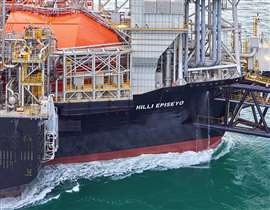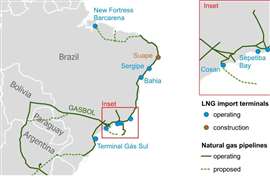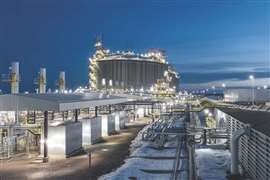Read this article in Français Deutsch Italiano Português Español
Golar inks 20-year Argentina FLNG charters tied to Vaca Muerta gas
May 02, 2025
Hilli, MKII FLNG units to anchor major new LNG export hub in Gulf of San Matias
 The Hilli Episeyo, the world’s first converted FLNG unit, has previously served in Cameroon and is now being redeployed. (Image: Golar LNG)
The Hilli Episeyo, the world’s first converted FLNG unit, has previously served in Cameroon and is now being redeployed. (Image: Golar LNG)
Golar LNG has taken a final investment decision (FID) and cleared all conditions for the redeployment of its Hilli Episeyo floating LNG (FLNG) vessel to Argentina, part of a 20-year agreement with Southern Energy S.A. (SESA) to unlock export volumes from the Vaca Muerta shale formation.
The project, which also includes a second long-term charter for a converted MKII FLNG unit, is among the largest FLNG developments in the world. The two units will be stationed offshore in the Gulf of San Matias in Argentina’s Río Negro province, monetizing shale gas transported from Neuquén.
Golar’s charter for the Hilli begins in 2027 and includes a fixed annual hire of $285 million, plus 25% of the Free on Board (FOB) gas price above $8 per MMBtu. The second unit, MKII FLNG, is expected to enter service in 2028 with an annual fixed hire of $400 million and a similar upside-linked tariff. The MKII contract remains subject to final investment decision and regulatory approval, expected in 2025.
Combined, the charters are expected to add $13.7 billion in revenue backlog to Golar over 20 years, not including inflation adjustments or any commodity-linked upside. Golar estimates that every additional $1 above the $8 threshold will add $100 million annually once both units are operational.
Both charters include downside protection for SESA in the event of weak global gas prices. If FOB prices fall below $7.5 per MMBtu, charter payments can be reduced, down to a floor at $6, with an overall cap of $210 million in potential discounts over the life of the contracts. Golar is not exposed to any further downside beyond that limit, and any discounts will be recoverable if prices rebound above $7.5.
“This is a transformative step for Golar and Argentina,” said Karl Fredrik Staubo, CEO of Golar LNG. “We are excited to partner with Argentina’s leading gas producers in establishing a new LNG export frontier. The Vaca Muerta formation offers a reliable and competitive source of natural gas, and our FLNG model provides a fast, flexible, and capital-light pathway to global markets.”
Major upstream backing
SESA is a newly formed LNG export company backed by a consortium of leading Argentinian gas players: Pan American Energy (30%), YPF (25%), Pampa Energia (20%), and Harbour Energy (15%). Golar holds the remaining 10% stake, aligning its shipping and liquefaction interests with upstream exposure.
The consortium has committed to supplying natural gas to the FLNGs under long-term gas sales agreements at fixed prices, indexed to U.S. inflation. The Vaca Muerta formation—regarded as the world’s second-largest shale gas resource—will be the feedstock source.
Initially, Hilli will be supplied with spare capacity from Argentina’s existing pipeline network. Over time, SESA plans to develop a dedicated pipeline from Vaca Muerta to the Gulf of San Matias to supply both FLNGs. Co-locating the units is expected to create operational synergies and reduce development costs.
Regulatory momentum
The government of Argentina has provided sweeping regulatory support for the project, granting the country’s first unrestricted 30-year LNG export permit. The project also qualifies for Argentina’s Incentive Regime for Large Investments (RIGI), which offers fiscal and regulatory benefits for strategic infrastructure projects. Environmental approvals at both provincial and federal levels are in place.
The move is a landmark for Argentina’s ambitions to become a regional LNG powerhouse, similar to the role played by the U.S. and Qatar in recent years. Until now, the country has primarily imported LNG during winter months, despite its vast shale resources.
FLNG expansion strategy
For Golar, the Argentina project deepens its strategic shift toward long-term FLNG infrastructure plays with upside exposure to global LNG markets. The company, listed on NASDAQ under the ticker GLNG, has transitioned from operating LNG carriers and FSRUs to becoming a pure-play FLNG provider.
The Hilli Episeyo, the world’s first converted FLNG unit, has previously served in Cameroon and is now being redeployed. The MKII FLNG is under conversion at CIMC Raffles shipyard in Yantai, China, and represents the next generation of Golar’s modular FLNG technology.
The contracts demonstrate Golar’s ability to monetize assets through long-term, inflation-indexed agreements with built-in upside. The deal structure also ensures alignment with upstream producers and includes mechanisms to buffer commodity price downside while capturing the benefits of higher global LNG prices.
If the charter terms are maintained for the full 20 years, the project could generate more than $20 billion in total gross revenue for Golar, depending on market conditions.
Argentina’s LNG ambitions take shape
The development marks a new chapter in Argentina’s gas export strategy. Unlike large-scale onshore liquefaction terminals, FLNG offers a more flexible and lower-cost alternative to monetize stranded or underutilized resources. By hosting FLNG units offshore, SESA and its partners avoid many of the permitting and infrastructure challenges that have hampered onshore LNG plans in the past.
SESA will oversee gas procurement, pipeline logistics, and LNG marketing. Golar will support operations of the FLNG units, leveraging experience from prior deployments in Africa.
Argentina’s entry into the LNG export market comes amid strong global demand for non-Russian LNG supply and limited new liquefaction capacity set to come online before 2027. With the Vaca Muerta formation delivering production costs as low as $2–3 per MMBtu, Argentina could offer some of the most competitive new LNG volumes on the global market.
Looking ahead
While SESA holds the option to shorten the charter terms after a 3-year notice—down to 12 years for Hilli and 15 for MKII—the consortium’s long-term vision and significant capital commitment signal a broader strategy to position Argentina as a permanent LNG exporter.
For Golar, the project fits neatly within its capital-light FLNG strategy and offers a pathway to additional projects as global gas markets continue to evolve.
MAGAZINE
NEWSLETTER

CONNECT WITH THE TEAM









